Assignment on Capital Project Proposal
VerifiedAdded on 2020/04/21
|7
|2161
|80
AI Summary
Contribute Materials
Your contribution can guide someone’s learning journey. Share your
documents today.

Capital Project Proposal
1
1
Secure Best Marks with AI Grader
Need help grading? Try our AI Grader for instant feedback on your assignments.
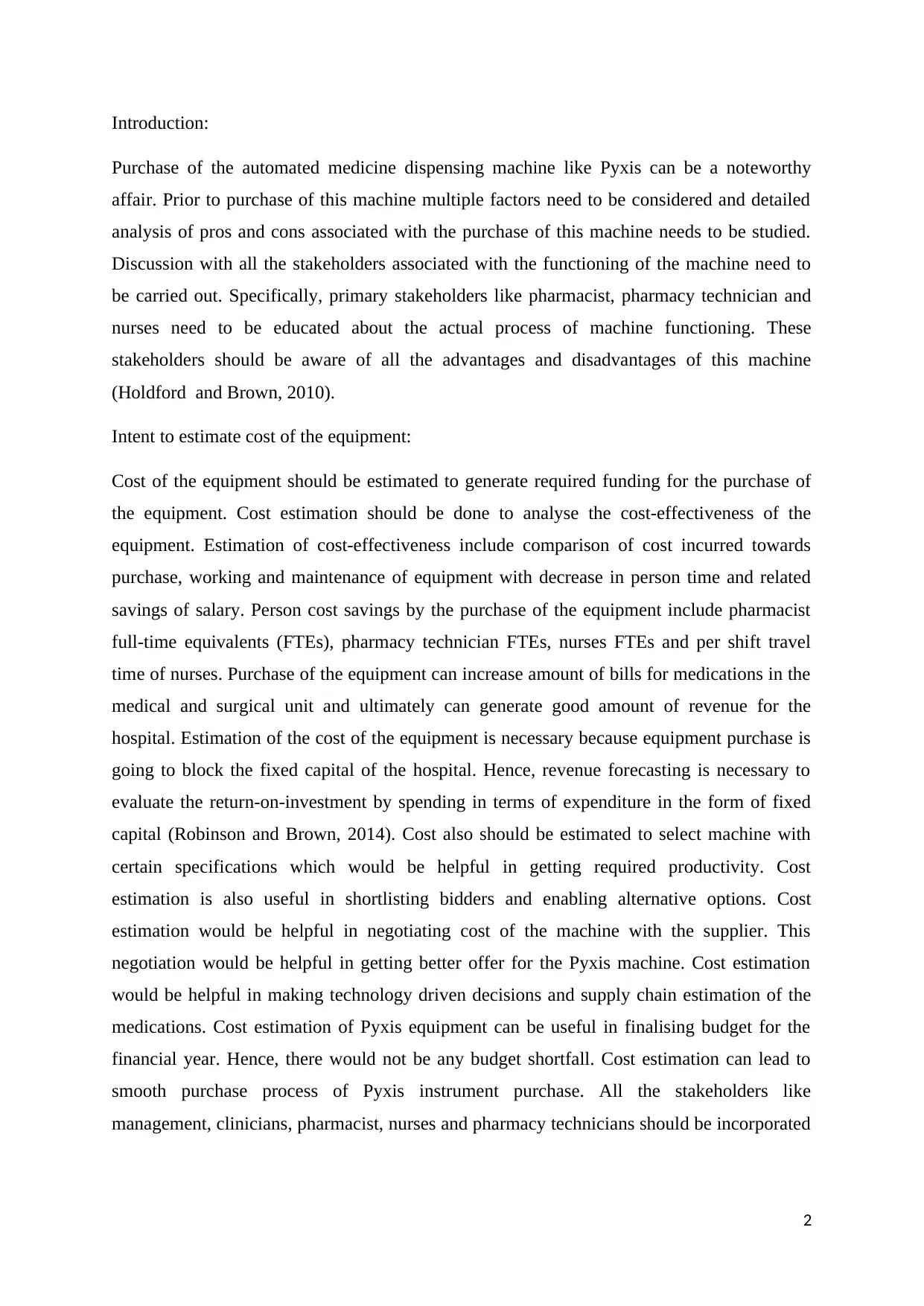
Introduction:
Purchase of the automated medicine dispensing machine like Pyxis can be a noteworthy
affair. Prior to purchase of this machine multiple factors need to be considered and detailed
analysis of pros and cons associated with the purchase of this machine needs to be studied.
Discussion with all the stakeholders associated with the functioning of the machine need to
be carried out. Specifically, primary stakeholders like pharmacist, pharmacy technician and
nurses need to be educated about the actual process of machine functioning. These
stakeholders should be aware of all the advantages and disadvantages of this machine
(Holdford and Brown, 2010).
Intent to estimate cost of the equipment:
Cost of the equipment should be estimated to generate required funding for the purchase of
the equipment. Cost estimation should be done to analyse the cost-effectiveness of the
equipment. Estimation of cost-effectiveness include comparison of cost incurred towards
purchase, working and maintenance of equipment with decrease in person time and related
savings of salary. Person cost savings by the purchase of the equipment include pharmacist
full-time equivalents (FTEs), pharmacy technician FTEs, nurses FTEs and per shift travel
time of nurses. Purchase of the equipment can increase amount of bills for medications in the
medical and surgical unit and ultimately can generate good amount of revenue for the
hospital. Estimation of the cost of the equipment is necessary because equipment purchase is
going to block the fixed capital of the hospital. Hence, revenue forecasting is necessary to
evaluate the return-on-investment by spending in terms of expenditure in the form of fixed
capital (Robinson and Brown, 2014). Cost also should be estimated to select machine with
certain specifications which would be helpful in getting required productivity. Cost
estimation is also useful in shortlisting bidders and enabling alternative options. Cost
estimation would be helpful in negotiating cost of the machine with the supplier. This
negotiation would be helpful in getting better offer for the Pyxis machine. Cost estimation
would be helpful in making technology driven decisions and supply chain estimation of the
medications. Cost estimation of Pyxis equipment can be useful in finalising budget for the
financial year. Hence, there would not be any budget shortfall. Cost estimation can lead to
smooth purchase process of Pyxis instrument purchase. All the stakeholders like
management, clinicians, pharmacist, nurses and pharmacy technicians should be incorporated
2
Purchase of the automated medicine dispensing machine like Pyxis can be a noteworthy
affair. Prior to purchase of this machine multiple factors need to be considered and detailed
analysis of pros and cons associated with the purchase of this machine needs to be studied.
Discussion with all the stakeholders associated with the functioning of the machine need to
be carried out. Specifically, primary stakeholders like pharmacist, pharmacy technician and
nurses need to be educated about the actual process of machine functioning. These
stakeholders should be aware of all the advantages and disadvantages of this machine
(Holdford and Brown, 2010).
Intent to estimate cost of the equipment:
Cost of the equipment should be estimated to generate required funding for the purchase of
the equipment. Cost estimation should be done to analyse the cost-effectiveness of the
equipment. Estimation of cost-effectiveness include comparison of cost incurred towards
purchase, working and maintenance of equipment with decrease in person time and related
savings of salary. Person cost savings by the purchase of the equipment include pharmacist
full-time equivalents (FTEs), pharmacy technician FTEs, nurses FTEs and per shift travel
time of nurses. Purchase of the equipment can increase amount of bills for medications in the
medical and surgical unit and ultimately can generate good amount of revenue for the
hospital. Estimation of the cost of the equipment is necessary because equipment purchase is
going to block the fixed capital of the hospital. Hence, revenue forecasting is necessary to
evaluate the return-on-investment by spending in terms of expenditure in the form of fixed
capital (Robinson and Brown, 2014). Cost also should be estimated to select machine with
certain specifications which would be helpful in getting required productivity. Cost
estimation is also useful in shortlisting bidders and enabling alternative options. Cost
estimation would be helpful in negotiating cost of the machine with the supplier. This
negotiation would be helpful in getting better offer for the Pyxis machine. Cost estimation
would be helpful in making technology driven decisions and supply chain estimation of the
medications. Cost estimation of Pyxis equipment can be useful in finalising budget for the
financial year. Hence, there would not be any budget shortfall. Cost estimation can lead to
smooth purchase process of Pyxis instrument purchase. All the stakeholders like
management, clinicians, pharmacist, nurses and pharmacy technicians should be incorporated
2
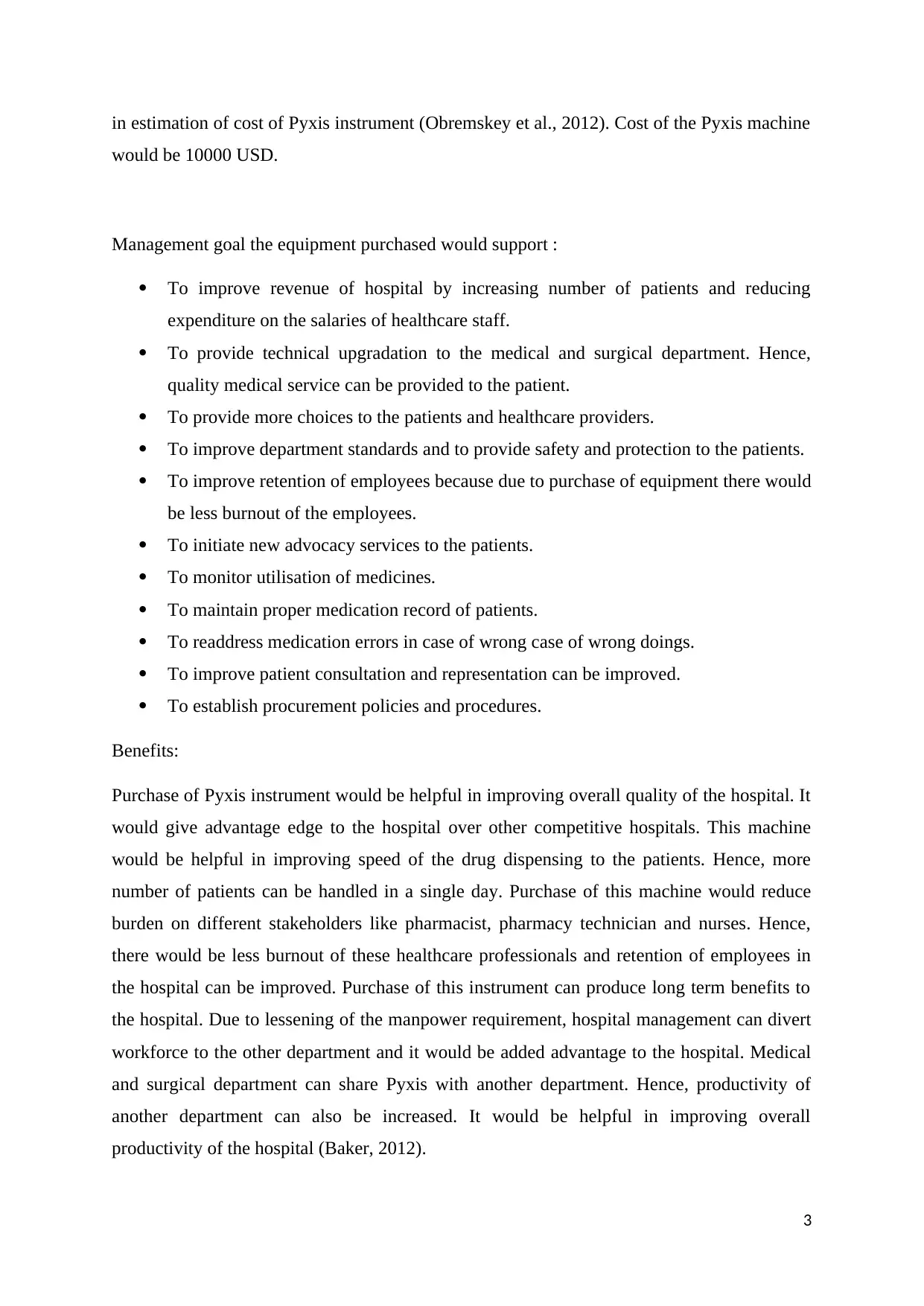
in estimation of cost of Pyxis instrument (Obremskey et al., 2012). Cost of the Pyxis machine
would be 10000 USD.
Management goal the equipment purchased would support :
To improve revenue of hospital by increasing number of patients and reducing
expenditure on the salaries of healthcare staff.
To provide technical upgradation to the medical and surgical department. Hence,
quality medical service can be provided to the patient.
To provide more choices to the patients and healthcare providers.
To improve department standards and to provide safety and protection to the patients.
To improve retention of employees because due to purchase of equipment there would
be less burnout of the employees.
To initiate new advocacy services to the patients.
To monitor utilisation of medicines.
To maintain proper medication record of patients.
To readdress medication errors in case of wrong case of wrong doings.
To improve patient consultation and representation can be improved.
To establish procurement policies and procedures.
Benefits:
Purchase of Pyxis instrument would be helpful in improving overall quality of the hospital. It
would give advantage edge to the hospital over other competitive hospitals. This machine
would be helpful in improving speed of the drug dispensing to the patients. Hence, more
number of patients can be handled in a single day. Purchase of this machine would reduce
burden on different stakeholders like pharmacist, pharmacy technician and nurses. Hence,
there would be less burnout of these healthcare professionals and retention of employees in
the hospital can be improved. Purchase of this instrument can produce long term benefits to
the hospital. Due to lessening of the manpower requirement, hospital management can divert
workforce to the other department and it would be added advantage to the hospital. Medical
and surgical department can share Pyxis with another department. Hence, productivity of
another department can also be increased. It would be helpful in improving overall
productivity of the hospital (Baker, 2012).
3
would be 10000 USD.
Management goal the equipment purchased would support :
To improve revenue of hospital by increasing number of patients and reducing
expenditure on the salaries of healthcare staff.
To provide technical upgradation to the medical and surgical department. Hence,
quality medical service can be provided to the patient.
To provide more choices to the patients and healthcare providers.
To improve department standards and to provide safety and protection to the patients.
To improve retention of employees because due to purchase of equipment there would
be less burnout of the employees.
To initiate new advocacy services to the patients.
To monitor utilisation of medicines.
To maintain proper medication record of patients.
To readdress medication errors in case of wrong case of wrong doings.
To improve patient consultation and representation can be improved.
To establish procurement policies and procedures.
Benefits:
Purchase of Pyxis instrument would be helpful in improving overall quality of the hospital. It
would give advantage edge to the hospital over other competitive hospitals. This machine
would be helpful in improving speed of the drug dispensing to the patients. Hence, more
number of patients can be handled in a single day. Purchase of this machine would reduce
burden on different stakeholders like pharmacist, pharmacy technician and nurses. Hence,
there would be less burnout of these healthcare professionals and retention of employees in
the hospital can be improved. Purchase of this instrument can produce long term benefits to
the hospital. Due to lessening of the manpower requirement, hospital management can divert
workforce to the other department and it would be added advantage to the hospital. Medical
and surgical department can share Pyxis with another department. Hence, productivity of
another department can also be increased. It would be helpful in improving overall
productivity of the hospital (Baker, 2012).
3
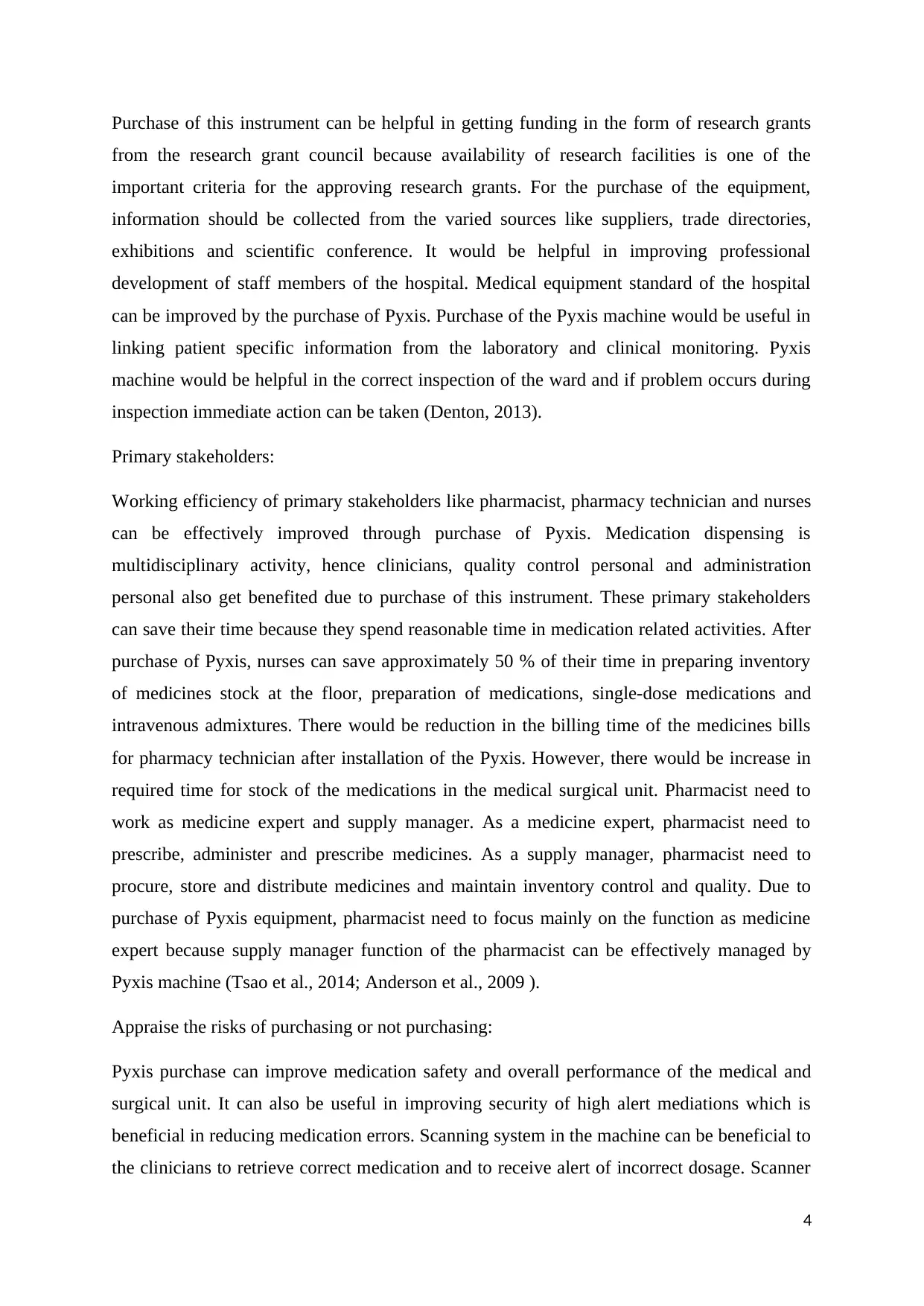
Purchase of this instrument can be helpful in getting funding in the form of research grants
from the research grant council because availability of research facilities is one of the
important criteria for the approving research grants. For the purchase of the equipment,
information should be collected from the varied sources like suppliers, trade directories,
exhibitions and scientific conference. It would be helpful in improving professional
development of staff members of the hospital. Medical equipment standard of the hospital
can be improved by the purchase of Pyxis. Purchase of the Pyxis machine would be useful in
linking patient specific information from the laboratory and clinical monitoring. Pyxis
machine would be helpful in the correct inspection of the ward and if problem occurs during
inspection immediate action can be taken (Denton, 2013).
Primary stakeholders:
Working efficiency of primary stakeholders like pharmacist, pharmacy technician and nurses
can be effectively improved through purchase of Pyxis. Medication dispensing is
multidisciplinary activity, hence clinicians, quality control personal and administration
personal also get benefited due to purchase of this instrument. These primary stakeholders
can save their time because they spend reasonable time in medication related activities. After
purchase of Pyxis, nurses can save approximately 50 % of their time in preparing inventory
of medicines stock at the floor, preparation of medications, single-dose medications and
intravenous admixtures. There would be reduction in the billing time of the medicines bills
for pharmacy technician after installation of the Pyxis. However, there would be increase in
required time for stock of the medications in the medical surgical unit. Pharmacist need to
work as medicine expert and supply manager. As a medicine expert, pharmacist need to
prescribe, administer and prescribe medicines. As a supply manager, pharmacist need to
procure, store and distribute medicines and maintain inventory control and quality. Due to
purchase of Pyxis equipment, pharmacist need to focus mainly on the function as medicine
expert because supply manager function of the pharmacist can be effectively managed by
Pyxis machine (Tsao et al., 2014; Anderson et al., 2009 ).
Appraise the risks of purchasing or not purchasing:
Pyxis purchase can improve medication safety and overall performance of the medical and
surgical unit. It can also be useful in improving security of high alert mediations which is
beneficial in reducing medication errors. Scanning system in the machine can be beneficial to
the clinicians to retrieve correct medication and to receive alert of incorrect dosage. Scanner
4
from the research grant council because availability of research facilities is one of the
important criteria for the approving research grants. For the purchase of the equipment,
information should be collected from the varied sources like suppliers, trade directories,
exhibitions and scientific conference. It would be helpful in improving professional
development of staff members of the hospital. Medical equipment standard of the hospital
can be improved by the purchase of Pyxis. Purchase of the Pyxis machine would be useful in
linking patient specific information from the laboratory and clinical monitoring. Pyxis
machine would be helpful in the correct inspection of the ward and if problem occurs during
inspection immediate action can be taken (Denton, 2013).
Primary stakeholders:
Working efficiency of primary stakeholders like pharmacist, pharmacy technician and nurses
can be effectively improved through purchase of Pyxis. Medication dispensing is
multidisciplinary activity, hence clinicians, quality control personal and administration
personal also get benefited due to purchase of this instrument. These primary stakeholders
can save their time because they spend reasonable time in medication related activities. After
purchase of Pyxis, nurses can save approximately 50 % of their time in preparing inventory
of medicines stock at the floor, preparation of medications, single-dose medications and
intravenous admixtures. There would be reduction in the billing time of the medicines bills
for pharmacy technician after installation of the Pyxis. However, there would be increase in
required time for stock of the medications in the medical surgical unit. Pharmacist need to
work as medicine expert and supply manager. As a medicine expert, pharmacist need to
prescribe, administer and prescribe medicines. As a supply manager, pharmacist need to
procure, store and distribute medicines and maintain inventory control and quality. Due to
purchase of Pyxis equipment, pharmacist need to focus mainly on the function as medicine
expert because supply manager function of the pharmacist can be effectively managed by
Pyxis machine (Tsao et al., 2014; Anderson et al., 2009 ).
Appraise the risks of purchasing or not purchasing:
Pyxis purchase can improve medication safety and overall performance of the medical and
surgical unit. It can also be useful in improving security of high alert mediations which is
beneficial in reducing medication errors. Scanning system in the machine can be beneficial to
the clinicians to retrieve correct medication and to receive alert of incorrect dosage. Scanner
4
Secure Best Marks with AI Grader
Need help grading? Try our AI Grader for instant feedback on your assignments.
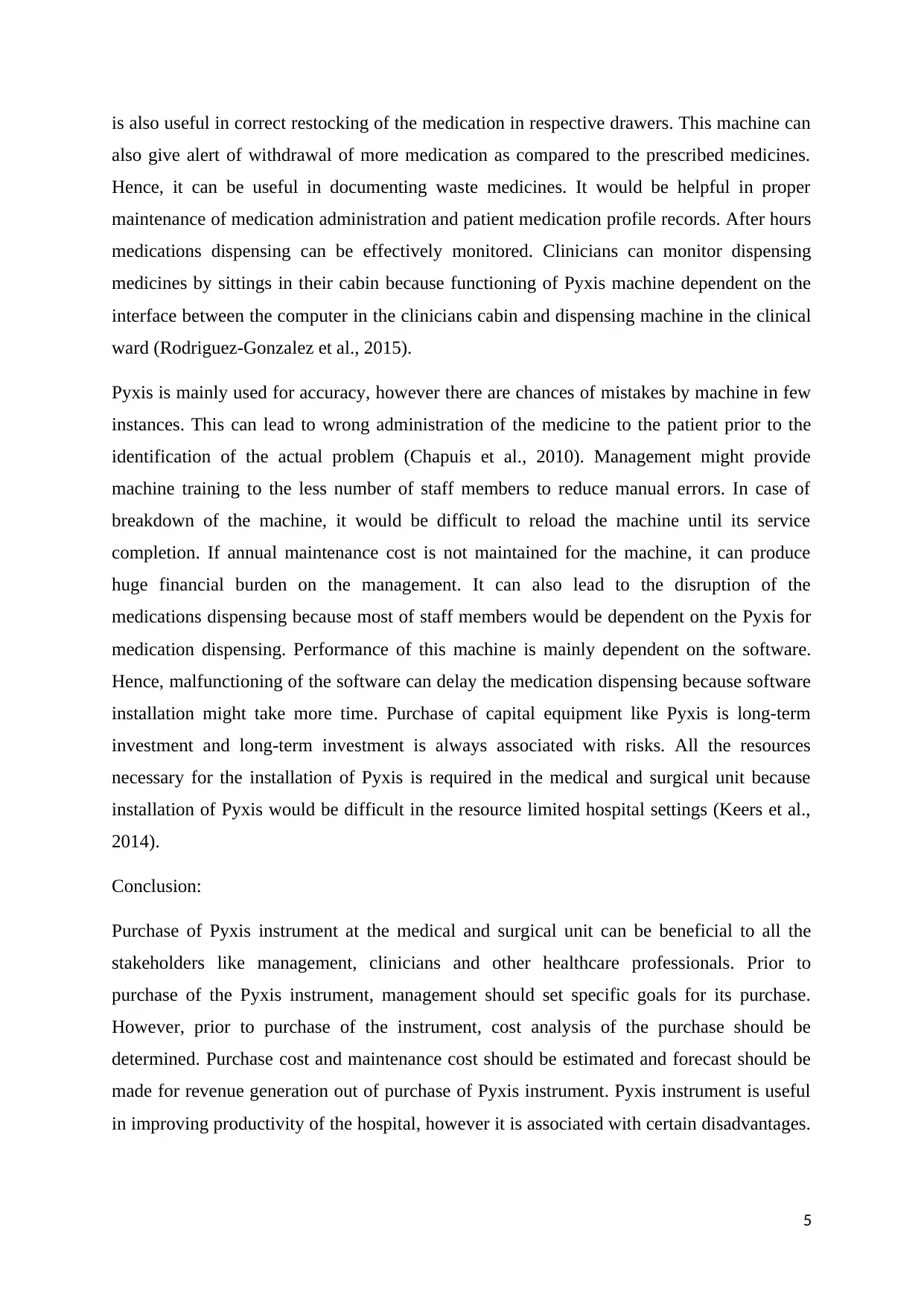
is also useful in correct restocking of the medication in respective drawers. This machine can
also give alert of withdrawal of more medication as compared to the prescribed medicines.
Hence, it can be useful in documenting waste medicines. It would be helpful in proper
maintenance of medication administration and patient medication profile records. After hours
medications dispensing can be effectively monitored. Clinicians can monitor dispensing
medicines by sittings in their cabin because functioning of Pyxis machine dependent on the
interface between the computer in the clinicians cabin and dispensing machine in the clinical
ward (Rodriguez-Gonzalez et al., 2015).
Pyxis is mainly used for accuracy, however there are chances of mistakes by machine in few
instances. This can lead to wrong administration of the medicine to the patient prior to the
identification of the actual problem (Chapuis et al., 2010). Management might provide
machine training to the less number of staff members to reduce manual errors. In case of
breakdown of the machine, it would be difficult to reload the machine until its service
completion. If annual maintenance cost is not maintained for the machine, it can produce
huge financial burden on the management. It can also lead to the disruption of the
medications dispensing because most of staff members would be dependent on the Pyxis for
medication dispensing. Performance of this machine is mainly dependent on the software.
Hence, malfunctioning of the software can delay the medication dispensing because software
installation might take more time. Purchase of capital equipment like Pyxis is long-term
investment and long-term investment is always associated with risks. All the resources
necessary for the installation of Pyxis is required in the medical and surgical unit because
installation of Pyxis would be difficult in the resource limited hospital settings (Keers et al.,
2014).
Conclusion:
Purchase of Pyxis instrument at the medical and surgical unit can be beneficial to all the
stakeholders like management, clinicians and other healthcare professionals. Prior to
purchase of the Pyxis instrument, management should set specific goals for its purchase.
However, prior to purchase of the instrument, cost analysis of the purchase should be
determined. Purchase cost and maintenance cost should be estimated and forecast should be
made for revenue generation out of purchase of Pyxis instrument. Pyxis instrument is useful
in improving productivity of the hospital, however it is associated with certain disadvantages.
5
also give alert of withdrawal of more medication as compared to the prescribed medicines.
Hence, it can be useful in documenting waste medicines. It would be helpful in proper
maintenance of medication administration and patient medication profile records. After hours
medications dispensing can be effectively monitored. Clinicians can monitor dispensing
medicines by sittings in their cabin because functioning of Pyxis machine dependent on the
interface between the computer in the clinicians cabin and dispensing machine in the clinical
ward (Rodriguez-Gonzalez et al., 2015).
Pyxis is mainly used for accuracy, however there are chances of mistakes by machine in few
instances. This can lead to wrong administration of the medicine to the patient prior to the
identification of the actual problem (Chapuis et al., 2010). Management might provide
machine training to the less number of staff members to reduce manual errors. In case of
breakdown of the machine, it would be difficult to reload the machine until its service
completion. If annual maintenance cost is not maintained for the machine, it can produce
huge financial burden on the management. It can also lead to the disruption of the
medications dispensing because most of staff members would be dependent on the Pyxis for
medication dispensing. Performance of this machine is mainly dependent on the software.
Hence, malfunctioning of the software can delay the medication dispensing because software
installation might take more time. Purchase of capital equipment like Pyxis is long-term
investment and long-term investment is always associated with risks. All the resources
necessary for the installation of Pyxis is required in the medical and surgical unit because
installation of Pyxis would be difficult in the resource limited hospital settings (Keers et al.,
2014).
Conclusion:
Purchase of Pyxis instrument at the medical and surgical unit can be beneficial to all the
stakeholders like management, clinicians and other healthcare professionals. Prior to
purchase of the Pyxis instrument, management should set specific goals for its purchase.
However, prior to purchase of the instrument, cost analysis of the purchase should be
determined. Purchase cost and maintenance cost should be estimated and forecast should be
made for revenue generation out of purchase of Pyxis instrument. Pyxis instrument is useful
in improving productivity of the hospital, however it is associated with certain disadvantages.
5
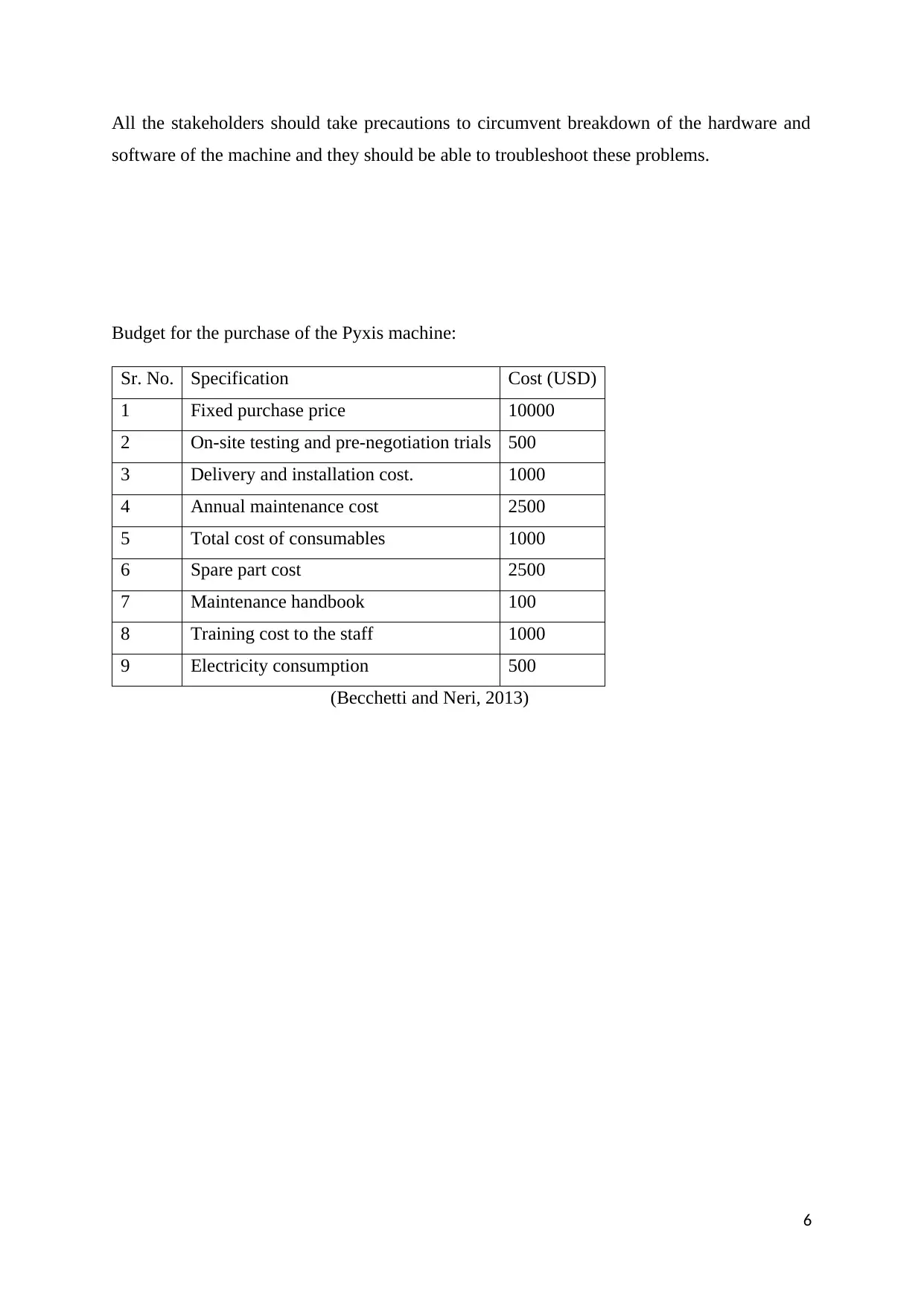
All the stakeholders should take precautions to circumvent breakdown of the hardware and
software of the machine and they should be able to troubleshoot these problems.
Budget for the purchase of the Pyxis machine:
Sr. No. Specification Cost (USD)
1 Fixed purchase price 10000
2 On-site testing and pre-negotiation trials 500
3 Delivery and installation cost. 1000
4 Annual maintenance cost 2500
5 Total cost of consumables 1000
6 Spare part cost 2500
7 Maintenance handbook 100
8 Training cost to the staff 1000
9 Electricity consumption 500
(Becchetti and Neri, 2013)
6
software of the machine and they should be able to troubleshoot these problems.
Budget for the purchase of the Pyxis machine:
Sr. No. Specification Cost (USD)
1 Fixed purchase price 10000
2 On-site testing and pre-negotiation trials 500
3 Delivery and installation cost. 1000
4 Annual maintenance cost 2500
5 Total cost of consumables 1000
6 Spare part cost 2500
7 Maintenance handbook 100
8 Training cost to the staff 1000
9 Electricity consumption 500
(Becchetti and Neri, 2013)
6
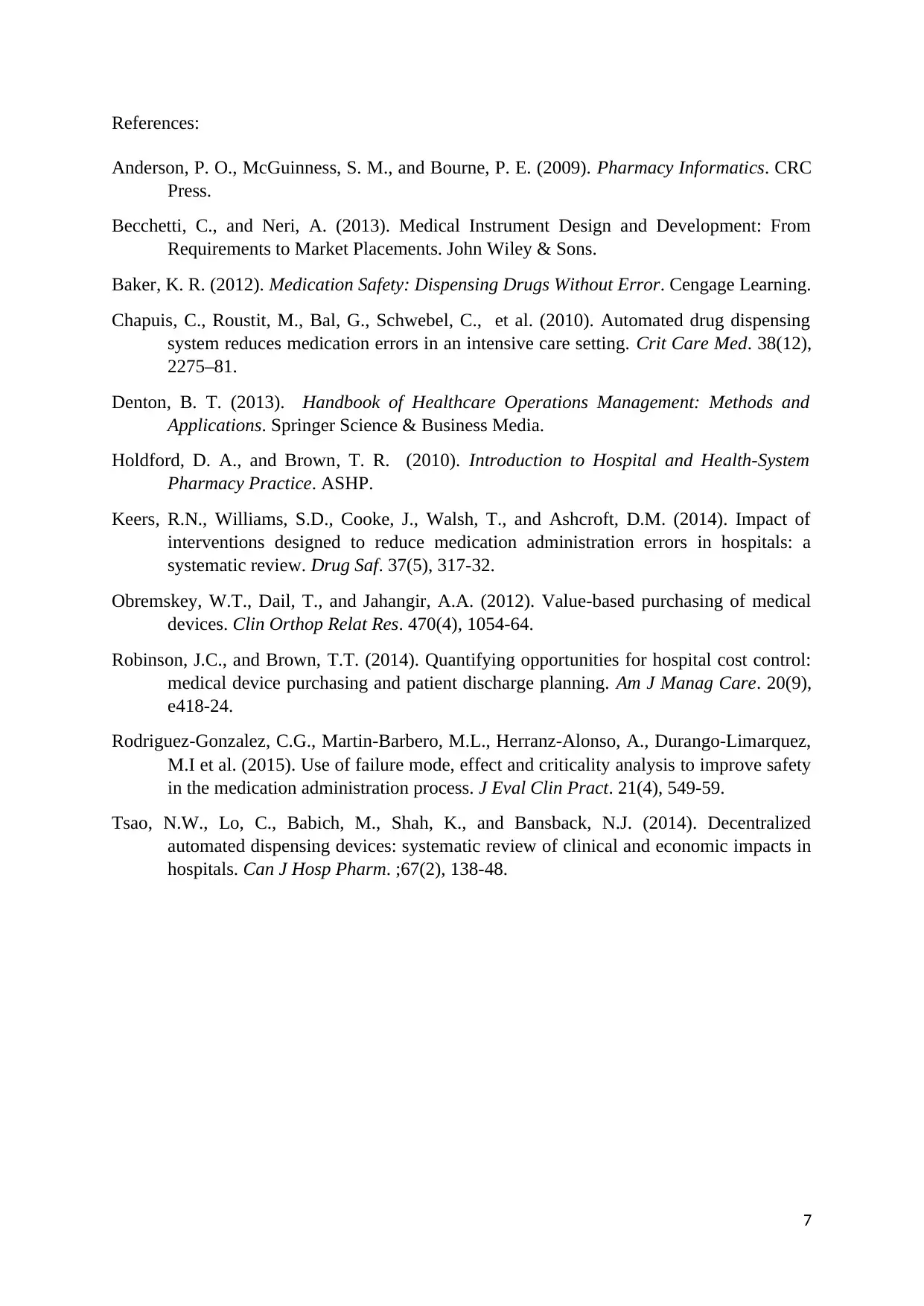
References:
Anderson, P. O., McGuinness, S. M., and Bourne, P. E. (2009). Pharmacy Informatics. CRC
Press.
Becchetti, C., and Neri, A. (2013). Medical Instrument Design and Development: From
Requirements to Market Placements. John Wiley & Sons.
Baker, K. R. (2012). Medication Safety: Dispensing Drugs Without Error. Cengage Learning.
Chapuis, C., Roustit, M., Bal, G., Schwebel, C., et al. (2010). Automated drug dispensing
system reduces medication errors in an intensive care setting. Crit Care Med. 38(12),
2275–81.
Denton, B. T. (2013). Handbook of Healthcare Operations Management: Methods and
Applications. Springer Science & Business Media.
Holdford, D. A., and Brown, T. R. (2010). Introduction to Hospital and Health-System
Pharmacy Practice. ASHP.
Keers, R.N., Williams, S.D., Cooke, J., Walsh, T., and Ashcroft, D.M. (2014). Impact of
interventions designed to reduce medication administration errors in hospitals: a
systematic review. Drug Saf. 37(5), 317-32.
Obremskey, W.T., Dail, T., and Jahangir, A.A. (2012). Value-based purchasing of medical
devices. Clin Orthop Relat Res. 470(4), 1054-64.
Robinson, J.C., and Brown, T.T. (2014). Quantifying opportunities for hospital cost control:
medical device purchasing and patient discharge planning. Am J Manag Care. 20(9),
e418-24.
Rodriguez-Gonzalez, C.G., Martin-Barbero, M.L., Herranz-Alonso, A., Durango-Limarquez,
M.I et al. (2015). Use of failure mode, effect and criticality analysis to improve safety
in the medication administration process. J Eval Clin Pract. 21(4), 549-59.
Tsao, N.W., Lo, C., Babich, M., Shah, K., and Bansback, N.J. (2014). Decentralized
automated dispensing devices: systematic review of clinical and economic impacts in
hospitals. Can J Hosp Pharm. ;67(2), 138-48.
7
Anderson, P. O., McGuinness, S. M., and Bourne, P. E. (2009). Pharmacy Informatics. CRC
Press.
Becchetti, C., and Neri, A. (2013). Medical Instrument Design and Development: From
Requirements to Market Placements. John Wiley & Sons.
Baker, K. R. (2012). Medication Safety: Dispensing Drugs Without Error. Cengage Learning.
Chapuis, C., Roustit, M., Bal, G., Schwebel, C., et al. (2010). Automated drug dispensing
system reduces medication errors in an intensive care setting. Crit Care Med. 38(12),
2275–81.
Denton, B. T. (2013). Handbook of Healthcare Operations Management: Methods and
Applications. Springer Science & Business Media.
Holdford, D. A., and Brown, T. R. (2010). Introduction to Hospital and Health-System
Pharmacy Practice. ASHP.
Keers, R.N., Williams, S.D., Cooke, J., Walsh, T., and Ashcroft, D.M. (2014). Impact of
interventions designed to reduce medication administration errors in hospitals: a
systematic review. Drug Saf. 37(5), 317-32.
Obremskey, W.T., Dail, T., and Jahangir, A.A. (2012). Value-based purchasing of medical
devices. Clin Orthop Relat Res. 470(4), 1054-64.
Robinson, J.C., and Brown, T.T. (2014). Quantifying opportunities for hospital cost control:
medical device purchasing and patient discharge planning. Am J Manag Care. 20(9),
e418-24.
Rodriguez-Gonzalez, C.G., Martin-Barbero, M.L., Herranz-Alonso, A., Durango-Limarquez,
M.I et al. (2015). Use of failure mode, effect and criticality analysis to improve safety
in the medication administration process. J Eval Clin Pract. 21(4), 549-59.
Tsao, N.W., Lo, C., Babich, M., Shah, K., and Bansback, N.J. (2014). Decentralized
automated dispensing devices: systematic review of clinical and economic impacts in
hospitals. Can J Hosp Pharm. ;67(2), 138-48.
7
1 out of 7
Your All-in-One AI-Powered Toolkit for Academic Success.
+13062052269
info@desklib.com
Available 24*7 on WhatsApp / Email
![[object Object]](/_next/static/media/star-bottom.7253800d.svg)
Unlock your academic potential
© 2024 | Zucol Services PVT LTD | All rights reserved.